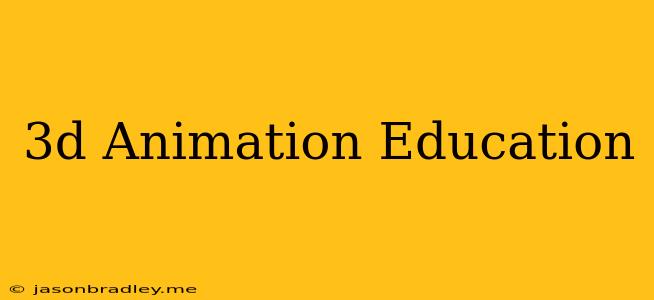The Ins and Outs of 3D Animation Education
3D animation is a rapidly growing field with exciting opportunities for creative individuals. If you're passionate about storytelling, visual effects, and bringing characters to life, a career in 3D animation could be your perfect fit. But how do you get started? This guide explores the educational pathways and resources available for aspiring 3D animators.
Educational Options:
-
Formal Education:
- Bachelor's Degree in Animation or a related field: Programs like Animation, Visual Effects, Digital Media, or Game Design provide a comprehensive foundation in animation principles, software, and industry practices.
- Associate's Degree in Animation or Digital Media: Offers a shorter path with a focus on technical skills and software proficiency.
- Certificate Programs: These intensive programs provide specialized training in specific animation software or techniques, often aimed at professionals looking to expand their skills.
-
Online Courses and Tutorials:
- Platforms like Udemy, Skillshare, and Coursera: Offer a wide range of courses on 3D animation software, character rigging, animation techniques, and more.
- YouTube Channels: Many talented artists and educators provide free tutorials and resources covering various aspects of 3D animation.
-
Bootcamps and Workshops:
- Immersive programs that provide intensive, hands-on training in a short period. These programs are often designed for career changers or individuals looking to quickly gain industry-relevant skills.
Essential Skills and Software:
- 3D Modeling: Ability to create 3D objects and environments using software like Maya, 3ds Max, Blender, or ZBrush.
- Animation: Knowledge of animation principles, character rigging, and software like Maya, Blender, or Cinema 4D.
- Texturing and Materials: Understanding of creating realistic or stylized textures and materials for 3D models.
- Lighting and Rendering: Proficiency in lighting techniques and rendering software like V-Ray, Arnold, or Cycles.
- Software Proficiency: Fluency in industry-standard software is crucial for success.
Building Your Portfolio:
- Personal Projects: Create your own animations, short films, or character designs to showcase your skills and creativity.
- Student Films: Participate in student projects or competitions to gain experience collaborating with others and working on larger-scale productions.
- Freelance Work: Take on freelance projects to build your portfolio and gain real-world experience.
The Importance of Networking:
- Attend industry events, conferences, and workshops: Connect with professionals, learn about new technologies, and build your network.
- Join online communities: Participate in forums, social media groups, and online communities dedicated to 3D animation.
- Reach out to studios and professionals: Show your work and inquire about potential opportunities.
Career Paths:
- Animator: Creates animated characters, objects, and scenes for films, TV shows, video games, and other media.
- 3D Modeler: Creates 3D assets for various applications, including animation, games, and visualization.
- VFX Artist: Uses 3D animation and compositing techniques to create visual effects for films, TV shows, and commercials.
- Game Developer: Contributes to the development of video games, creating characters, environments, and animations.
Final Thoughts:
A career in 3D animation is a challenging yet rewarding path. With the right education, skills, and dedication, you can create captivating visuals and bring your creative visions to life. Whether you choose a formal education, online learning, or a blend of both, it's essential to constantly learn and develop your skills to keep up with the ever-evolving industry. Remember to build a strong portfolio, network with other professionals, and stay passionate about your craft.
